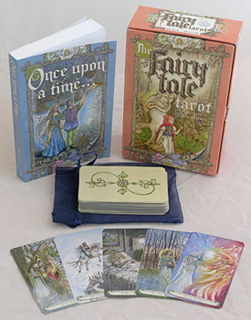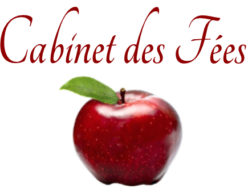The Fairy Tale Tarot
by Lisa Hunt, Llewellyn, 2009.
Reviewed by Erzebet YellowBoy
 The Fairy Tale Tarot by Lisa Hunt comes neatly packaged with the book Once Upon a Time in which Hunt briefly touches on the history of the fairy tale before expansively describing the major and minor arcana, each of which comes with a fairy tale of its own. Tarot such as this aren’t so much divinatory tools as they are guideposts through the psyche, and I can think of few things better to guide us than the stories with which many of us grew up. One of the things that has always appealed to me about fairy tales is their universality—the core stories are found in a wide variety of cultures and offer a timeless affinity with their archetypal characters. Fairy tales may appear to be about wolves and witches and things that go bump in the forest, but at their heart they are about the human condition, often the female condition in particular.
The Fairy Tale Tarot by Lisa Hunt comes neatly packaged with the book Once Upon a Time in which Hunt briefly touches on the history of the fairy tale before expansively describing the major and minor arcana, each of which comes with a fairy tale of its own. Tarot such as this aren’t so much divinatory tools as they are guideposts through the psyche, and I can think of few things better to guide us than the stories with which many of us grew up. One of the things that has always appealed to me about fairy tales is their universality—the core stories are found in a wide variety of cultures and offer a timeless affinity with their archetypal characters. Fairy tales may appear to be about wolves and witches and things that go bump in the forest, but at their heart they are about the human condition, often the female condition in particular.
The tarot themselves have played their part in the exploration of this condition, beginning in the 18th century when they became more than a simple table game. Each of the major arcana can be said to represent a situation in which almost everyone will find themselves at some point in their life. The cards are meant to ease us through transition, either by pointing out the aspects of our situation that may escape our notice, or by foretelling what might happen should we choose one path over another.
In The Fairy Tale Tarot, Hunt has has culled stories from across the globe for the arcanas, using material from Spain, Denmark, India, Brazil, Germany and Ireland (to name but a few), and even including a “universal” story as the final card in the major arcana, where Happily Ever After replaces The World. And this is what we have to ask ourselves about this deck: how well has Hunt matched the stories to the cards? These correspondences are only meaningful if the stories chosen somehow enhance the traditional attributions of the tarot, or express them in sympathetic terms. To answer this question in full would require a lengthy post in which every card was inspected and judged. I will settle instead for one card, a familiar card to many of us who read the tarot, and one of the most misunderstood cards in the deck: The Devil.
The Devil is an ambitious card, of that type of ambition that can easily turn into obsession. It represents imprisonment, a condition in which we find ourselves trapped by forces either external or internal, or both. Hunt has chosen the story of Bluebeard and his locked door, here calling the card Temptation rather than Death, to illustrate the meaning of the card. She offers the keywords confronting the shadows and likens the story of Bluebeard and his wives to that of Pandora’s box. Hunt writes of the need to address our shadows, to acknowledge our darker sides rather than projecting them outwards, onto others. These are fitting correspondences, and I am happy to report that this card is not a fluke. Even through the minor arcana she maintains a keen sense of which story best exemplifies which card.
Of course, the only way to get to know the tarot is to use it, and so I did. Interestingly, the most significant card in my reading was The Empress, here The Fairy Godmother, a character who has been much on my mind of late as it is to certain persons who have played that role that the third print issue of Cabinet des Fées is dedicated. The reading itself was accurate, and it was a pleasure to have my old familiar storybook friends offering their advice. The one thing that does disturb me about this deck is its cleanliness. I prefer the bloodier tales, where happily ever after came at great cost if at all, where the threat of being cooked in an oven wasn’t representative of some fatal flaw in my psyche, it was a call to run like mad for the door. However, those stories serve their purpose and this deck serves another, and at the end of the day this quibble is a matter of personal taste. Hunt has connected the stories, their symbols and the characters that populate them with the tarot in a way that provides fresh insights into both the stories and the cards. After reading the book and using the deck, it is obvious that the marriage of these two methods of comprehending ourselves and those things that influence us is a good one.
